Biggest bang for the buck
03/04/2008
Paulsen Home / Sports Channel / Bullz-Eye Home
Everybody loves a bargain. Whether it’s a sweet deal on a car, a good price on a camcorder or just a free dessert with dinner, most of us like to stretch our dollar as far as it can go.
The same goes for the NBA. Winning in all sports is about maximizing the production of your players. In professional sports, this can come at a price. Save for a few franchises with owners who are willing to win at any cost -- James Dolan and Mark Cuban, I’m looking at you -- most NBA general managers are asked to maximize production while keeping payroll under control.
To that end, GMs always keep an eye out for bargains, players who put up good numbers at a reduced cost. I thought it would be interesting to try to identify these players, so I took the NBA’s Efficiency statistic...
EFF = ((Points + Rebounds + Assists + Steals + Blocks) - ((Field Goals Att. - Field Goals Made) + (Free Throws Att. - Free Throws Made) + Turnovers))
...and calculated each player’s expected efficiency for the season. Efficiency is a nice stat because it takes into account all positive and negative stats. Players that shoot a higher percentage will fare better while low-percentage shooters or scorers who don’t produce in other categories will fare worse.
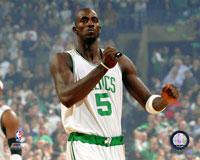 To account for injuries, the projection expects that the player will play the same proportion of future games as he has thus far this season. I normalized the number with respect to the team’s pace (the number of possessions a team uses per game), since it’s not really fair to compare players on teams that play vastly different styles, such as Detroit (90.4 possessions per game) and Denver (101.7 possessions per game). I then divided each player’s salary by this projected efficiency to give us a price that each team will pay this season for each point of efficiency.
To account for injuries, the projection expects that the player will play the same proportion of future games as he has thus far this season. I normalized the number with respect to the team’s pace (the number of possessions a team uses per game), since it’s not really fair to compare players on teams that play vastly different styles, such as Detroit (90.4 possessions per game) and Denver (101.7 possessions per game). I then divided each player’s salary by this projected efficiency to give us a price that each team will pay this season for each point of efficiency.
It’s tough to compare players at each end of the salary spectrum due to the tremendous ratio from top to bottom. For example, even though Kevin Garnett (above) is a productive player with respect to his financial peers, his $23.8 million salary is 56 times the salary of the best bargain in the league. So, to get a better idea of the best bargains at each salary level, I split the league up into five categories based on salary:
Superstars: $13+ million
Stars: $9 to $13 million
Starters: $5 to $9 million
First rounders & journeymen: $1 to $5 million
Second rounders: Less than $1 million
The top 30 salaries should go to the top 30 players in the league -- the superstars. These are the franchise (or the supposed franchise) players who demand max contracts when they enter free agency. The next 30 players make up the star group, and these salaries range from $9 million to $13 million. When a team signs a player to a deal in this range, they expect the player to be the second (or at worst the third) best player on the team. Next up is the starter category, which includes the salaries for the next 90 players. These first three categories include 150 players, a group that represents all the starters in the league.
The last two categories generally include journeymen and recent draft picks who are still on their first contract. First-round players generally make $1 million to $5 million, depending on how long they’ve been in the league and where they were taken in the draft. Players making less than $1 million are second-round draft picks or vets playing for the league minimum.
We’ll start with this group and work our way up the salary scale. After all, these guys are actually the best bargains in the league. I’ll list the top five players, their respective salaries and how much each team is projected to pay them this season for each point of efficiency that they’ll produce.
Second rounders (players who make less than $1 million)
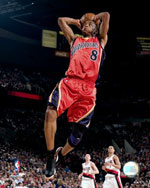 1. Jamario Moon, SF, Raptors
1. Jamario Moon, SF, Raptors
Salary: $427,163
$/EFF: $417
2. Monta Ellis, PG, Warriors (right)
Salary: $770,610
$/EFF: $531
3. Juan Carlos Navarro, PG, Grizzlies
Salary: $538,090
$/EFF: $732
4. Paul Millsap, PF, Jazz
Salary: $687,456
$/EFF: $740
5. David Lee, PF, Knicks
Salary: $990,600
$/EFF: $748
That’s a pretty good lineup right there. Ellis, Millsap and Navarro were second-round picks, while Moon went undrafted and Lee was drafted with the last pick in the first round. Ellis and Navarro are both combo guards who have more of a score-first mentality while Millsap and Lee are tough-as-nails power forwards who do the dirty work inside. Moon is an athletic swingman who finished third in this year’s Slam Dunk Contest.
Ellis and Navarro will be two of the top free agents this summer, while Millsap and Moon will probably have to wait until next summer to cash in. Lee will be a restricted free agent that summer, so expect the Knicks to hold onto him until then (at least).
The next five: Ryan Gomes, Timberwolves ($750); Beno Udrih, Kings ($773); Craig Smith, Timberwolves ($825); Daniel Gibson, Cavs ($917); Anthony Carter, Nuggets ($982)
First rounders & journeymen (players who make $1 million to $5 million)
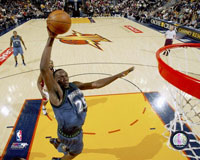 1. Rajon Rondo, PG, Celtics
1. Rajon Rondo, PG, Celtics
Salary: $1.23 million
$/EFF: $1091
2. Danny Granger, SF, Pacers
Salary: $1.52 million
$/EFF: $1145
3. Jason Maxiell, PF, Pistons
Salary: $1.04 million
$/EFF: $1185
4. Linas Kleiza, F, Nuggets
Salary: $1.01 million
$/EFF: $1218
5. Al Jefferson, FC, Timberwolves (right)
Salary: $2.48 million
$/EFF: $1227
Here are five former first-round picks who are still playing under their rookie contracts. The salaries are a little bigger, and so are the numbers, but they still aren’t as good of a bargain as that first group. Jefferson has already cashed in with a five-year, $65 million deal that starts next season. Rondo is thriving as the pass-first point guard for the suddenly stacked Celtics. He will become a restricted free agent in 2010.
Maxiell and Kleiza are both important bench players for their respective teams, while Granger has started all but one of the Pacers’ games. All three players become restricted free agents next summer.
The next five: Josh Smith, Hawks ($1292); Jordan Farmar, Lakers ($1295); Jarrett Jack, Trailblazers ($1333); Kyle Lowry, Grizzlies ($1352), Francisco Garcia, Kings ($1355)
Starters (players who make $5 million to $9 million)
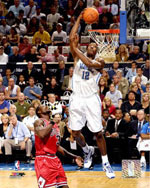 1. Dwight Howard, C, Magic (right)
1. Dwight Howard, C, Magic (right)
Salary: $6.06 million
$/EFF: $2652
2. Emeka Okafor, C, Bobcats
Salary: $5.43 million
$/EFF: $3464
3. Hedo Turkoglu, SF, Magic
Salary: $6.37 million
$/EFF: $3998
4. Brendan Haywood, C, Wizards
Salary: $5.00 million
$/EFF: $4002
5. Leandro Barbosa, PG, Suns
Salary: $5.60 million
$/EFF: $4940
Some of the bigger names are starting to emerge. Howard and Okafor were taken #1/#2 in the 2004 draft, and both players are in the final year of their rookie contract. Howard has already upgraded to a five-year, $79 million deal that starts next season, while Okafor will become a restricted free agent this summer.
Turkoglu is playing All-Star caliber ball and the Magic are fortunate to have him locked in for another season at a reasonable rate. Haywood has been somewhat lackluster for most of his career but seems to be thriving now in Washington; the Wizards have him under contract through 2010. Meanwhile, the Suns are in a terrific position, having Barbosa locked in for three more years for less than $20 million.
The next five: Nick Collison, Supersonics ($5098); Corey Maggette, Clippers ($5104); Antonio McDyess, Pistons ($5149); Chris Kaman, Clippers ($5281); Udonis Haslem, Heat ($5340)
Stars (players who make $9 million to $13 million)
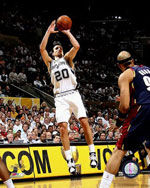 1. Marcus Camby, C, Nuggets
1. Marcus Camby, C, Nuggets
Salary: $9.00 million
$/EFF: $5020
2. Manu Ginobili, SG, Spurs (right)
Salary: $9.08 million
$/EFF: $5565
3. Carlos Boozer, PF, Jazz
Salary: $11.26 million
$/EFF: $5623
4. David West, PF, Hornets
Salary: $10.65 million
$/EFF: $6013
5. Chauncey Billups, PG, Pistons
Salary: $10.00 million
$/EFF: $6091
If an NBA GM can figure out a way to put this team together, he’d be competing for a title. Considering all that he brings to the table, Camby is a vastly underrated center. He won Defensive Player of the Year last season and his contract actually decreases over the next two years, so the Nuggets are sitting pretty at center. Similarly, the Spurs locked Ginobili in before he really blossomed, and he also has two years remaining on his deal.
Boozer’s contract, which seemed a little outrageous a few years ago, is positively frugal now. Utah has him signed for another season and then he’ll likely opt-out of the final year of his contract in the summer of 2009. The Hornets signed West to a great deal; his contract decreases over the next three years before a player option in 2011. Lastly, it’s funny to see Billups on this list considering he just signed a new deal. Still, it looks like the Pistons are getting good production for what they’re paying him.
The next five: Josh Howard, Mavericks ($6148); Tyson Chandler, Hornets ($6237); Andre Miller, Sixers ($6347); Steve Nash, Suns ($6441); Brad Miller, Kings ($6478)
Superstars (players who make $13+ million)
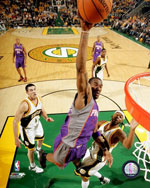 1. LeBron James, SF, Cavaliers
1. LeBron James, SF, Cavaliers
Salary: $13.04 million
$/EFF: $5708
2. Amare Stoudemire, PF, Suns (right)
Salary: $13.76 million
$/EFF: $6071
3. Yao Ming, C, Rockets
Salary: $13.76 million
$/EFF: $6814
4. Chris Bosh, FC, Raptors
Salary: $13.04 million
$/EFF: $6845
5. Dirk Nowitzki, PF, Mavericks
Salary: $16.36 million
$/EFF: $7556
What can you say that hasn’t already been said about this group? These are guys who will be All-Stars as long as they’re upright. LeBron’s salary seems more than fair considering all that he does for the Cavs. He is locked in for two more seasons, so if the Cavs haven’t made a jump by next summer, expect the “LeBron Opt-Out Watch” to start in earnest.
The rest of the guys in this group are franchise players, though the Rockets have to be wondering if they can trust Yao to stay healthy given all of his injuries the last three years. Stoudemire, Bosh and Nowitzki are three of highest-valued players in the league, and for good reason.
The next five: Carmelo Anthony, Nuggets ($8115); Dwyane Wade, Heat ($8344); Vince Carter, Nets ($8533); Shawn Marion, Heat ($8581); Pau Gasol, Lakers ($8607)
Conclusion
So how does $/EFF translate to wins and losses? A simple tally confirms that 29 of the 50 players on this list play on winning teams. Moreover, 15 of the 20 players in the last two groups play for winners, so it’s clear that if you are getting good production out of your big-money guys, you stand a pretty good chance of winning more games than you lose.
On a whole, the league pays approximately $6800 for each point of efficiency, so general managers could use that figure to give themselves an idea what a young player is worth when he hits free agency. Take Monta Ellis, who has an adjusted efficiency of 1450 this season.
$6800 * 1450 = $9.86 million
That salary looks a little high to me, but it wouldn’t surprise me if Ellis signs a deal that approaches that number by the end of the contract. If I were a GM, I’d offer him a deal that started around $6.5 million. If he posted exactly the same numbers next season, I’d have a player producing at a similar rate as Hedo Turkoglu and Leandro Barbosa, two of the guys on this list.
Another thing this exercise taught me is just how much money these guys make. Garnett, for example, earns $292,683 for each of his team’s 82 games, whether or not he plays. Even Jamario Moon, who “only” makes $427,163 for the season, earns $5,209 per game. That’s not bad for a night’s work!
Send questions and comments to jpaulsen@bullz-eye.com.






